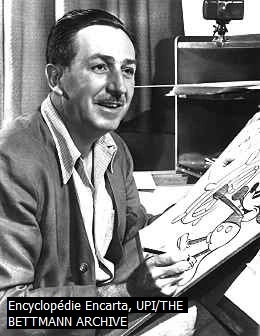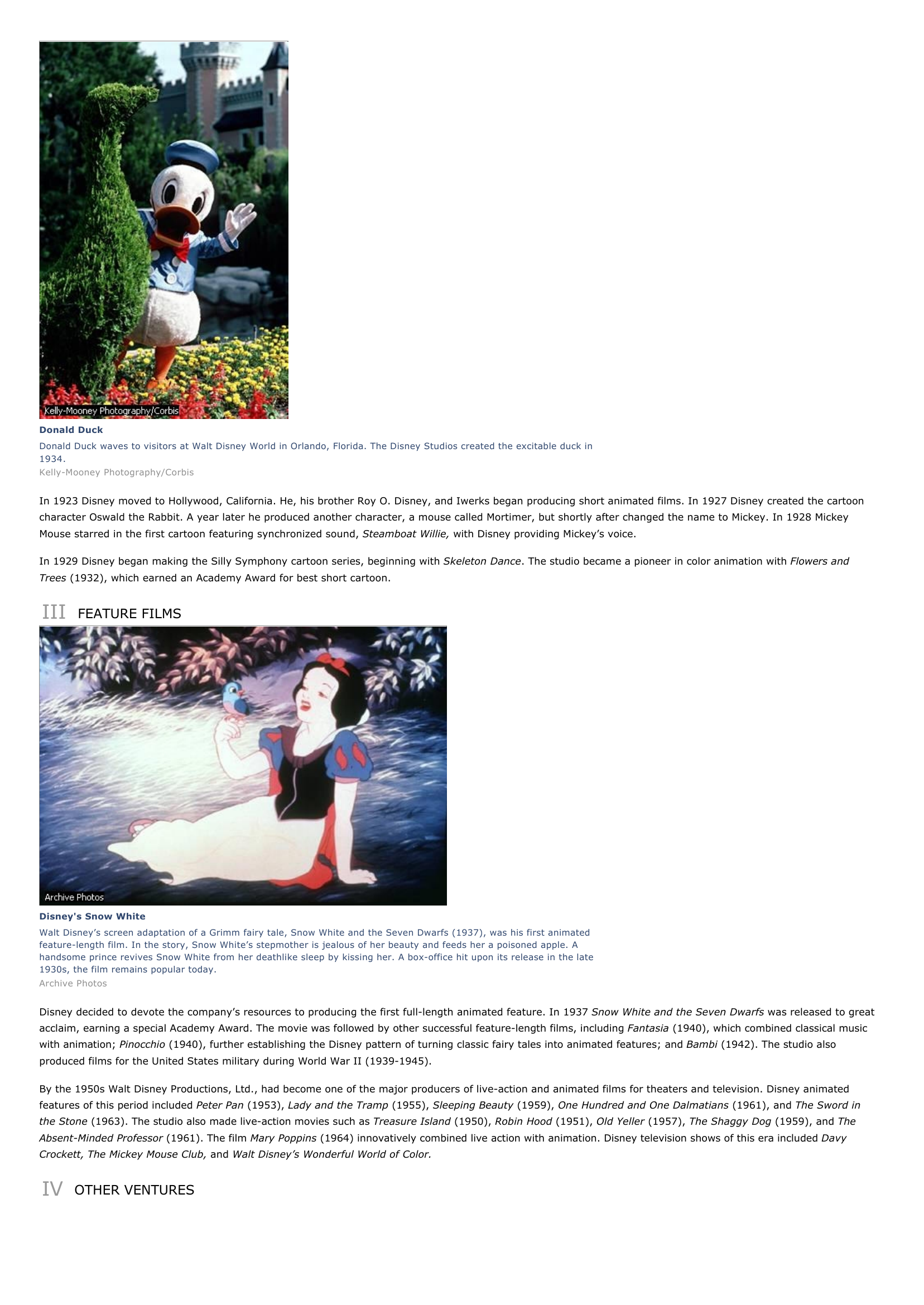Walt Disney I INTRODUCTION Walt Disney Walt Disney, an American cartoonist and film producer, started an entertainment empire with his creation of animated movies and world-renowned amusement parks.
Publié le 12/05/2013

Extrait du document


«
Donald DuckDonald Duck waves to visitors at Walt Disney World in Orlando, Florida.
The Disney Studios created the excitable duck in1934.Kelly-Mooney Photography/Corbis
In 1923 Disney moved to Hollywood, California.
He, his brother Roy O.
Disney, and Iwerks began producing short animated films.
In 1927 Disney created the cartooncharacter Oswald the Rabbit.
A year later he produced another character, a mouse called Mortimer, but shortly after changed the name to Mickey.
In 1928 MickeyMouse starred in the first cartoon featuring synchronized sound, Steamboat Willie, with Disney providing Mickey’s voice.
In 1929 Disney began making the Silly Symphony cartoon series, beginning with Skeleton Dance .
The studio became a pioneer in color animation with Flowers and Trees (1932), which earned an Academy Award for best short cartoon.
III FEATURE FILMS
Disney's Snow WhiteWalt Disney’s screen adaptation of a Grimm fairy tale, Snow White and the Seven Dwarfs (1937), was his first animatedfeature-length film.
In the story, Snow White’s stepmother is jealous of her beauty and feeds her a poisoned apple.
Ahandsome prince revives Snow White from her deathlike sleep by kissing her.
A box-office hit upon its release in the late1930s, the film remains popular today.Archive Photos
Disney decided to devote the company’s resources to producing the first full-length animated feature.
In 1937 Snow White and the Seven Dwarfs was released to great acclaim, earning a special Academy Award.
The movie was followed by other successful feature-length films, including Fantasia (1940), which combined classical music with animation; Pinocchio (1940), further establishing the Disney pattern of turning classic fairy tales into animated features; and Bambi (1942).
The studio also produced films for the United States military during World War II (1939-1945).
By the 1950s Walt Disney Productions, Ltd., had become one of the major producers of live-action and animated films for theaters and television.
Disney animatedfeatures of this period included Peter Pan (1953), Lady and the Tramp (1955), Sleeping Beauty (1959), One Hundred and One Dalmatians (1961), and The Sword in the Stone (1963).
The studio also made live-action movies such as Treasure Island (1950), Robin Hood (1951), Old Yeller (1957), The Shaggy Dog (1959), and The Absent-Minded Professor (1961).
The film Mary Poppins (1964) innovatively combined live action with animation.
Disney television shows of this era included Davy Crockett, The Mickey Mouse Club, and Walt Disney’s Wonderful World of Color.
IV OTHER VENTURES.
»
↓↓↓ APERÇU DU DOCUMENT ↓↓↓
Liens utiles
- Animation I INTRODUCTION Finding Nemo A clown fish named Marlin, left, and his friend Dory search for Marlin's son in the computer-animated feature film Finding Nemo (2003).
- Alfred Hitchcock I INTRODUCTION Alfred Hitchcock (1899-1980), British-born American motion-picture director and producer, noted for his technically innovative and psychologically complex thrillers.
- Luciano PavarottiIINTRODUCTIONLuciano PavarottiRenowned Italian tenor Luciano Pavarotti was known for his mastery of the highest notes of a tenor's range and for hisjovial personality, which helped him earn a wide popular following.
- Dante Alighieri I INTRODUCTION Dante Alighieri (1265-1321), Italian poet, and one of the supreme figures of world literature, who was admired for the depth of his spiritual vision and for the range of his intellectual accomplishment.
- Ernest Hemingway I INTRODUCTION Ernest Hemingway Twentieth-century American author Ernest Hemingway wrote novels and stories that reflected his rich life experiences as a war correspondent, outdoor sportsman, and bullfight enthusiast.












